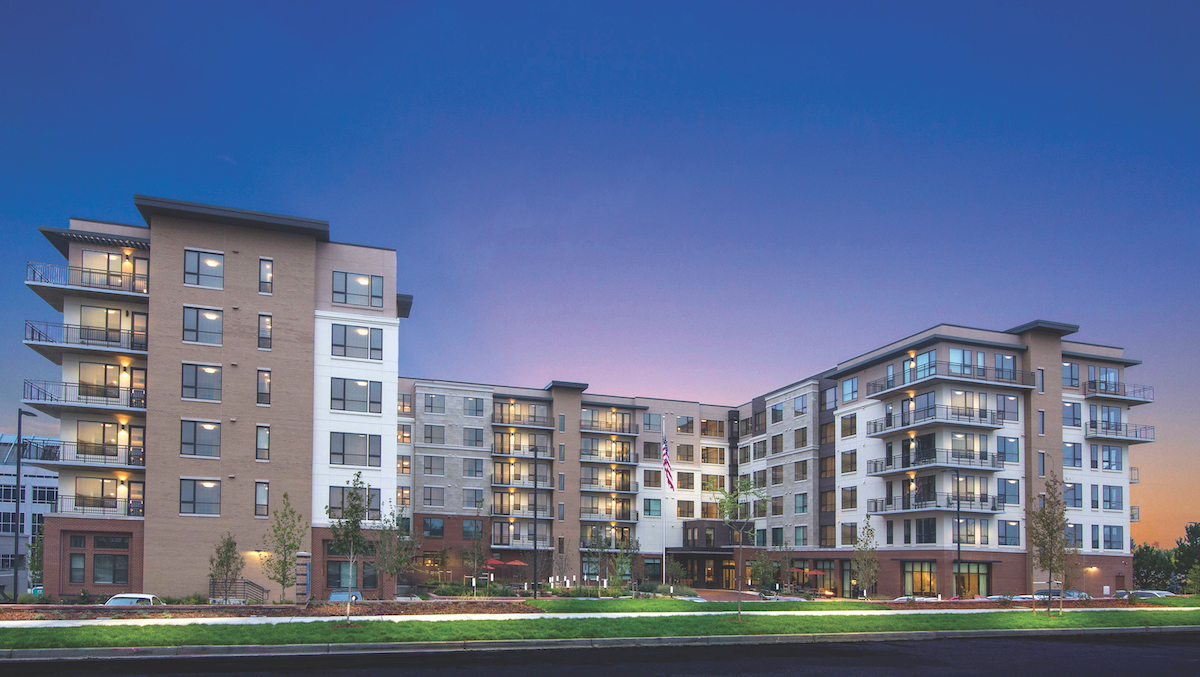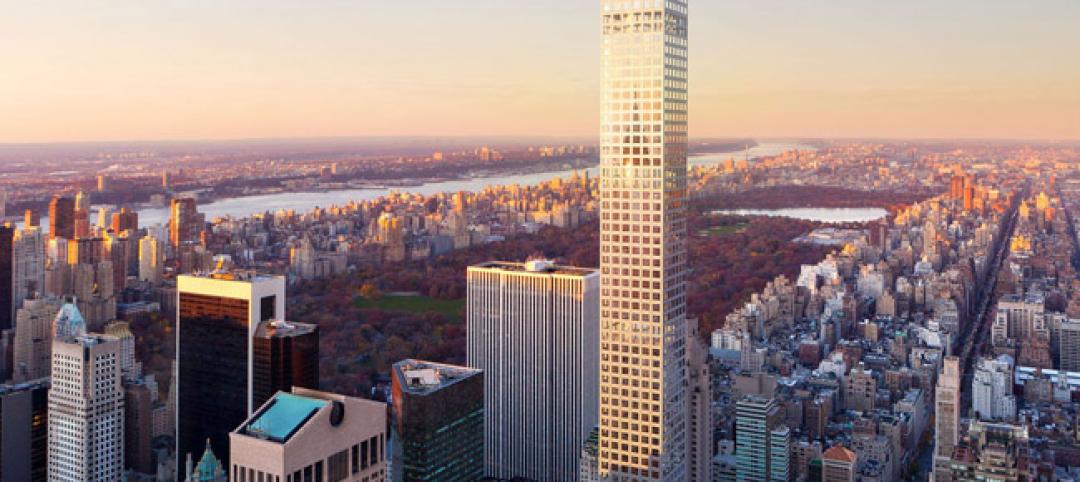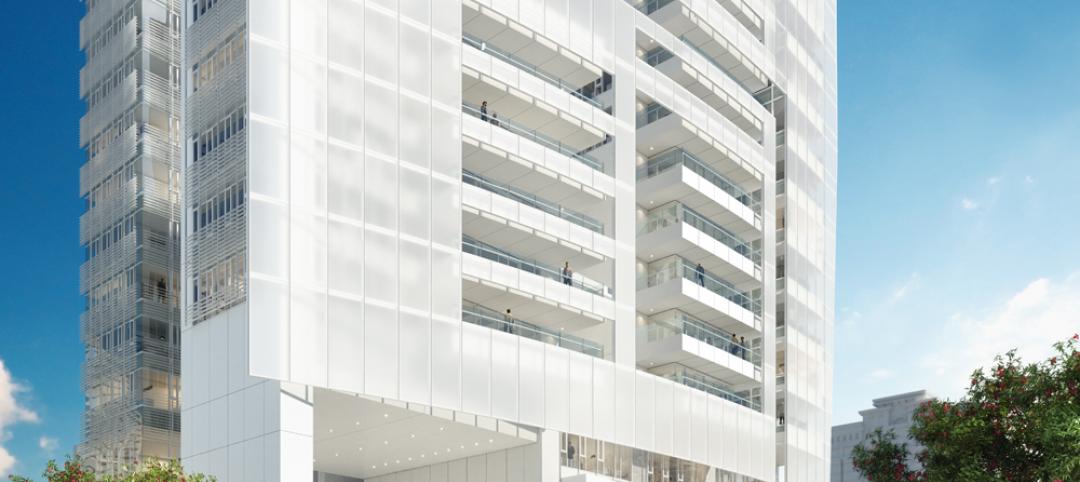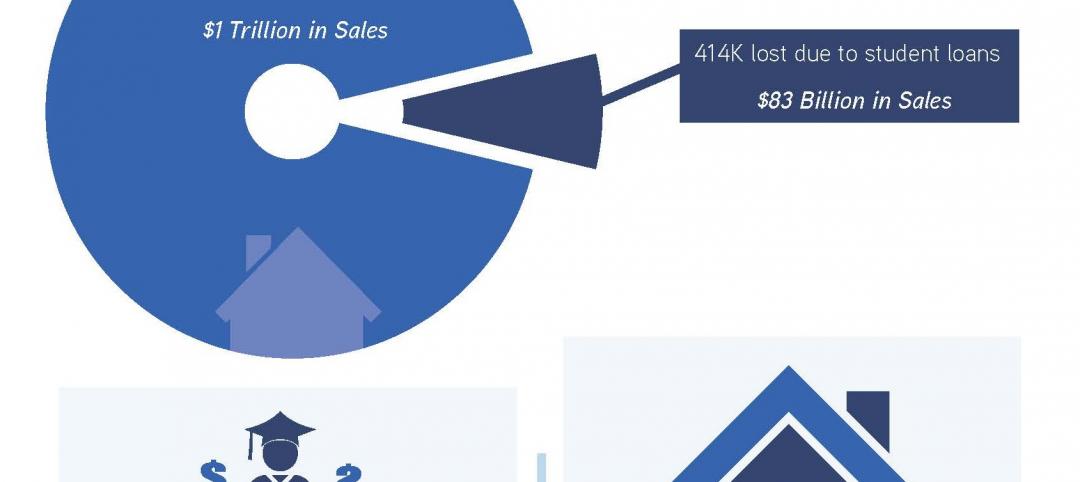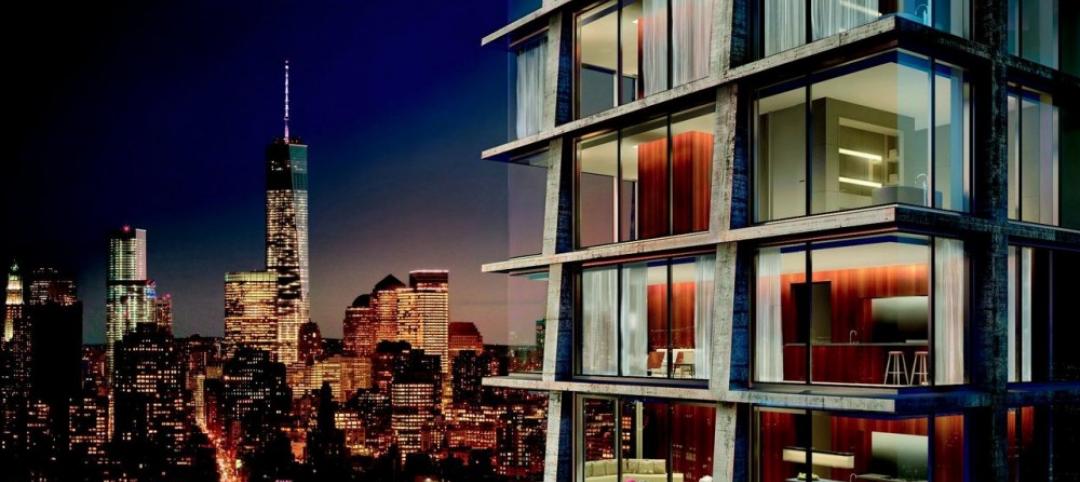Enter The Carillon at Belleview Station from the streets of Denver’s bustling Tech Center District, and your first impression is of a residence that is contemporary, sleek, and upscale. The sliding glass doors open to a quartz-and-wood reception desk with a staggered row of pendant lights overhead and a striking abstract painting on the wall. A floor-to-ceiling stone-look porcelain tile wall is accented with a greenery-filled window that peers into the expansive lobby.
The colors are fun. The finishes are fresh. The feel is energized urban living. This is senior living with style.
“It’s beautiful, but the beauty is very functional, very modern,” said Angie Erickson, General Manager of the 173,000-sf complex, which has 139 independent and assisted-living suites and 24 memory care suites. “I’ve been in the residential industry 17 years, and this is the most conducive environment I’ve ever worked in.”
“We’re always trying to change the perception of what senior living is,” said Shauna Revo, Associate and Project Design Manager at StudioSIX5, the interior design firm for The Carillon at Belleview Station.
Communities for the 55+ set are changing, said B. Dean Maddalena, AIA, NCARB, IIDA, ASID, NEWH, President of Austin, Texas–based StudioSIX5, which he founded in 2003 and which specializes in interior design for senior living. “Senior communities used to be about seclusion and security,” he said. “Now, seniors want to be in the city, integrating with the surrounding community. It’s a huge, positive shift.”
StudioSIX5 has completed more than 400 senior living projects in 34 states and the District of Columbia, from active adult communities to memory care centers. The firm recently compiled 11 trends that Maddalena believes will guide design decisions in senior living communities.
1. Senior living residential style will be more eclectic. Seniors are ready for variety in furnishings and finishes, more layering of patterns, said Maddalena. “By this time in their lives, people have traveled, they’ve been everywhere,” he said. “They realize that one room doesn’t have to be all Chippendale. It can be a mix of styles.”
2. Senior living communities are taking advantage of open floor plans. “It used to be that every activity needed its own room, which sat empty most of the day,” said Maddalena. That’s changed. The movie room can also serve as the chapel, the lecture hall, a meeting room, or a training room. “We don’t really have libraries in our senior communities anymore,” he said. “It’s more like a Starbucks with magazines.”
The Carillon’s dining room is outfitted with sliding doors that open up access to the private family dining room, the activity room, and the theater. “It’s phenomenal when you have events,” said Erickson. “You’re not trying to shove people into little rooms.”
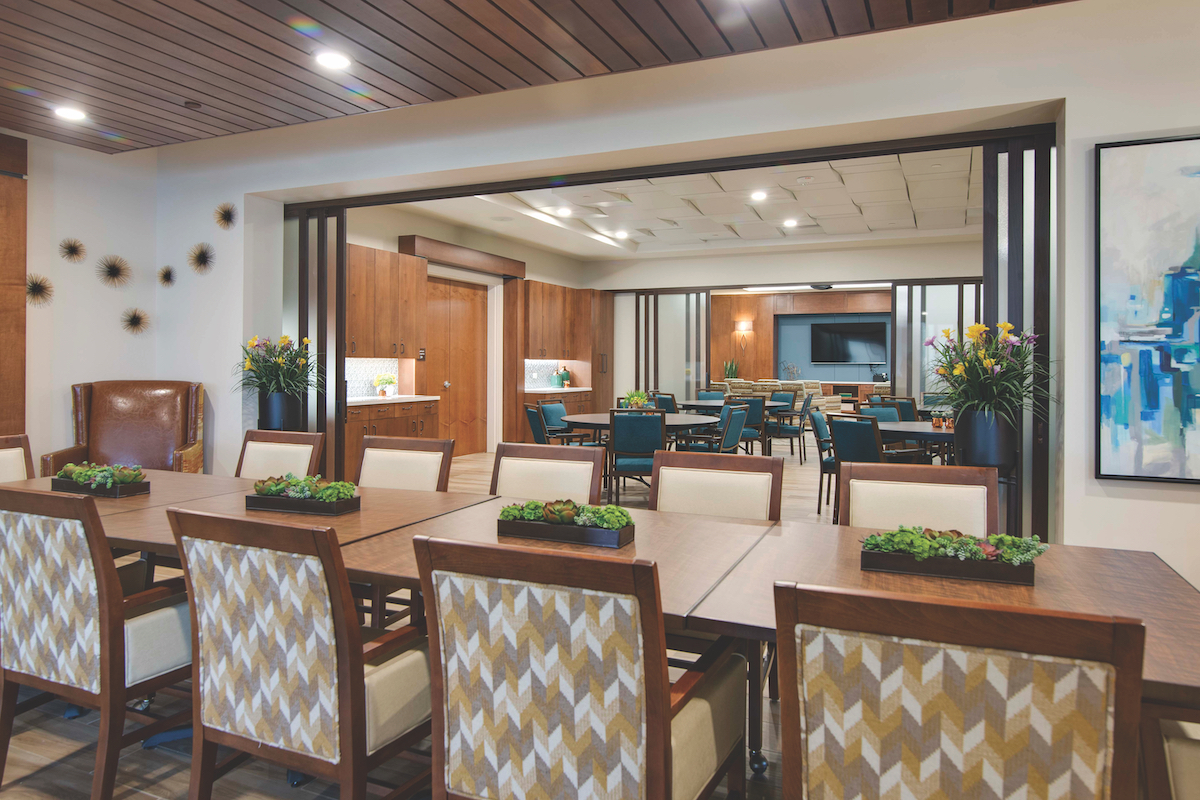
#2 Open Floor Plan. Photo: Michael Lowry Photography
3. Crisp jewel tones will gain in popularity for paint, furnishings, and accessories. Jewel tones and saturated colors permeate StudioSIX5’s communities, from upholstered chairs and draperies to decorative pillows and curated art.
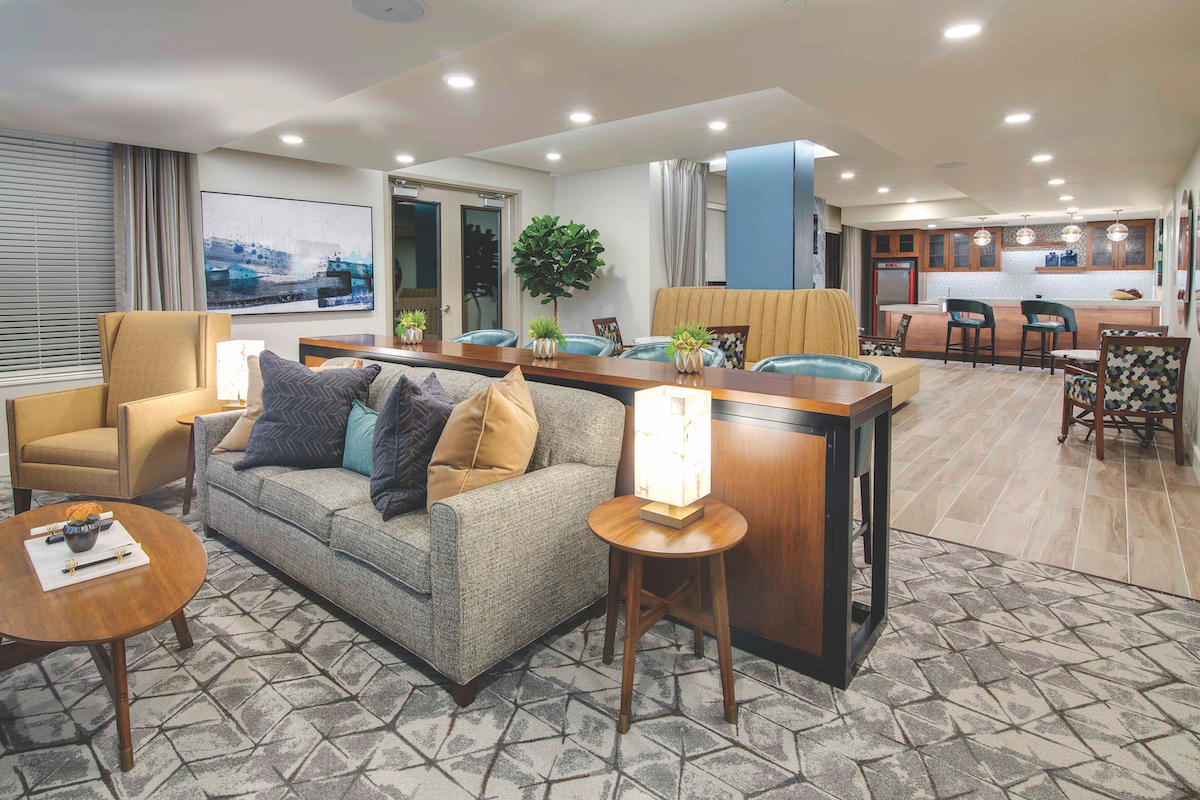
#3 Jewel tones and saturated colors. Photo: Michael Lowry Photography
4. Cool-toned grays and silver accents will shift to warmer neutrals and metallics in finish selections. The once ubiquitous gray is moving toward a “beige/gray in-between,” Maddalena said. He and his team test how colors relate to seniors’ changing visual capabilities. “We wear yellow glasses to simulate how the changes in seniors’ corneas affect how they see colors,” he said. “Gray doesn’t look much like anything. When you introduce beige, it mellows everything out for the more saturated colors.”
Metallic finishes fit well with clean, contemporary design; they add heightened luxury and an organic quality. Metallics are showing up in lighting fixtures, consoles, side tables, and upholstered seating areas.
5. Digitally printed materials will bring heightened personalization to senior living design. “We can print photos on laminate and make custom countertops,” said Maddalena. The firm has printed a resident’s face on a pillow and presented it as a gift. They’ve photo-reproduced the Chicago skyline and upholstered it on a banquette, and used the same technique to make a carpet that looks like grass.
6. Lighter wood tones are gaining popularity in furnishings and millwork. “The pendulum is swinging away from dark, dark woods,” said Maddalena. Now it’s more mid-tones and browns—natural walnut, birch, ash, and natural rift-cut oak—for cabinetry millwork in reception desks, dining areas, and individual apartment kitchens.
7. Services and amenities should integrate 55+ residents with the community. As active seniors looking for independent and assisted living gravitate to urban centers to take advantage of restaurants, shops, entertainment, and healthcare, there’s a growing emphasis on providing amenities that draw in the public to help residents feel engaged with their neighbors. The Carillon’s hair salon is open to—and popular with—the public, and its sixth-floor sky lounge can be rented out for functions.
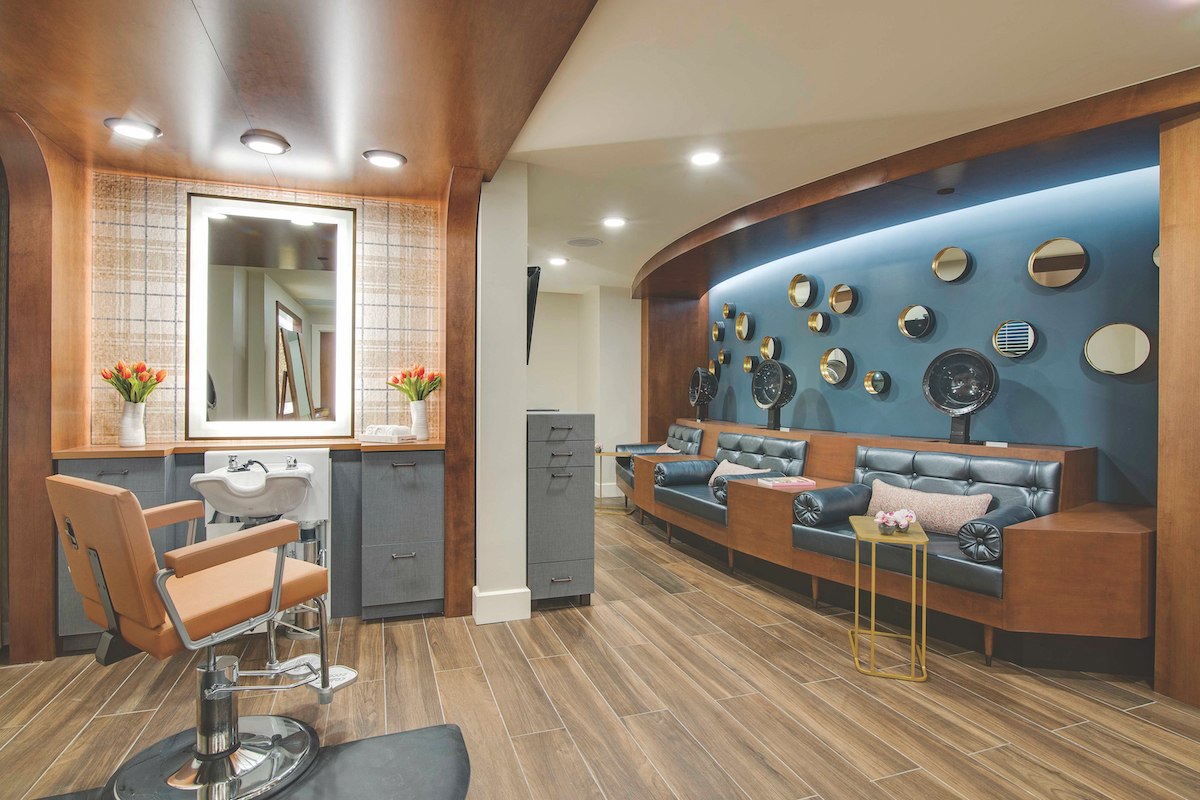
#7 Services and amenities. Photo: Michael Lowry Photography
8. Senior living communities will create more outdoor amenity “destinations.” Outdoor spaces should be an integral part of activity programming, even in hot climates. An outdoor theater with lawn chairs, where residents can watch a movie and have dinner and cocktails; a greenhouse with a gardening club; or dining spaces where residents can cook for themselves and host parties—spaces like these enliven the 55+ residential experience.
“We work on a cooking function, a lounging function, a fire pit, and a pool,” said Claire Richards, a StudioSIX5 Senior Associate who led the design team for the Overture Barrett, a 55+ community in Kennesaw, Ga. “It’s about making that another living space.” Pergolas, fountains, large-screen TVs, grills, and green lawns for yoga, bocce, or cornhole are also options. “We usually do a little pet walk along the exterior,” said Richards.
Outdoor activities should be sited so that residents can easily see from one to another. “It was once popular to spread the amenity spaces throughout the community, but we learned that out of sight was out of mind,” Maddalena said. Now, it’s important for residents to be able to see what else is going on as they engage in an activity.
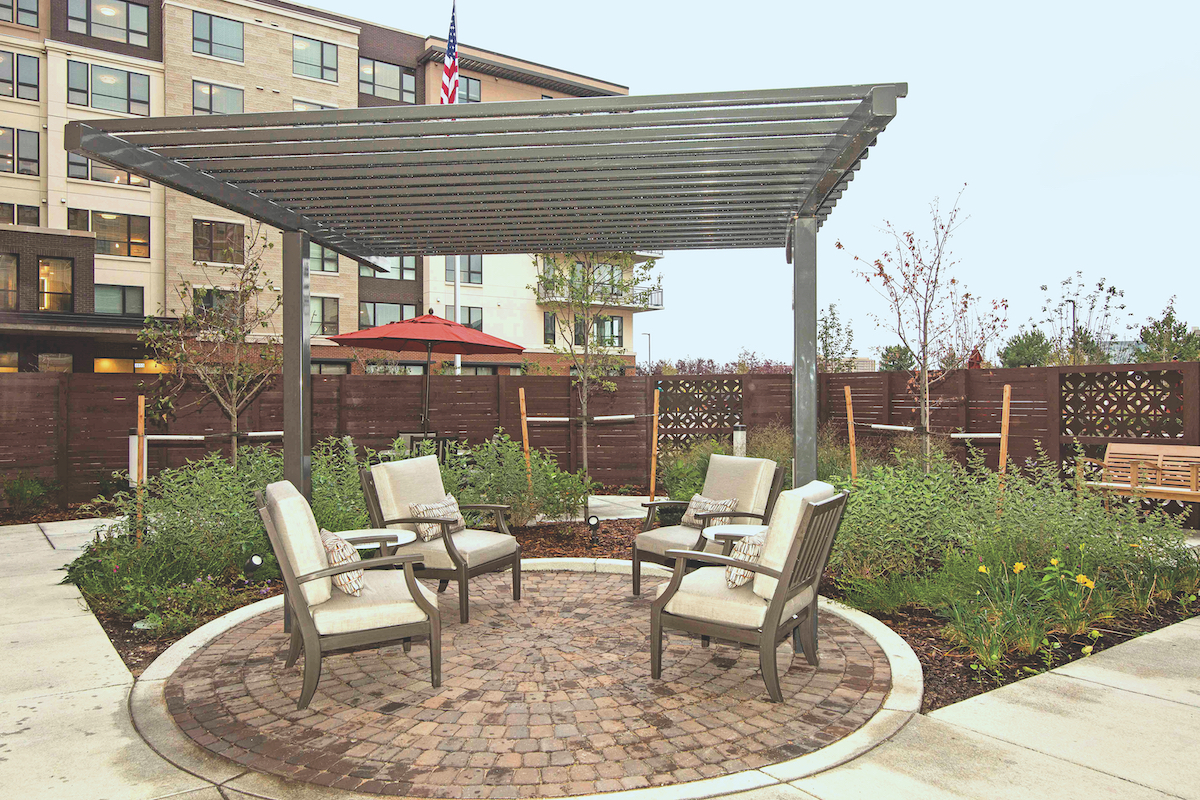
#8 Outdoor amenity destinations. Photo: Michael Lowry Photography
9. LVT and porcelain are becoming materials of choice. As recently as a few years ago, Maddalena said, StudioSIX5 would not even consider specifying wood-print luxury vinyl tile or porcelain tile: the quality just wasn’t up to the standards of the firm—or the 55+ end users. Now, LVT and porcelain are accepted market-wide, and are StudioSIX5’s go-to products for their durability, style, and affordability.
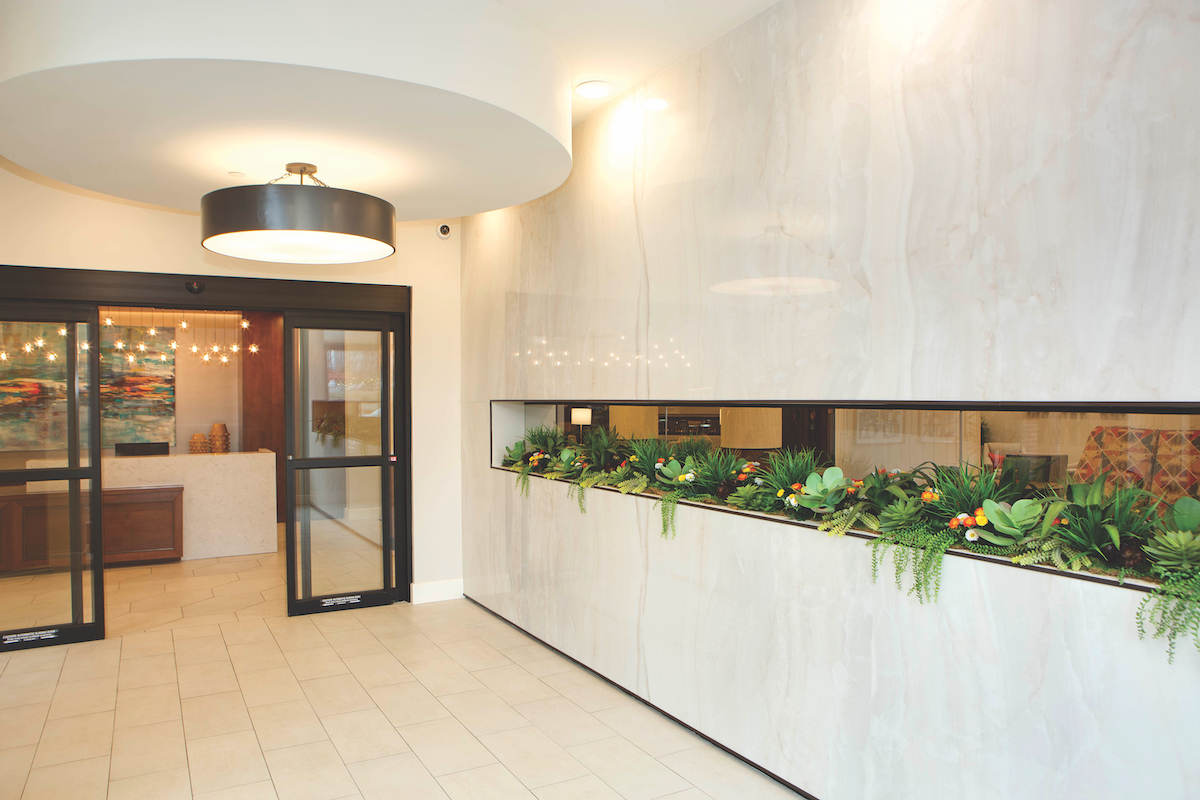
#9 LVT and porcelain tile. Photo: Michael Lowry Photography
10. Bars with self-serve point-of-service systems will rise in popularity. These systems allow residents to grab a snack or a drink, charge it on their keycard, and get a bill at the end of the month. Senior communities will still have happy hours where employees will serve the drinks, Maddalena said, but self-service is becoming more of an option. Staffing is expensive, he said, and “you want your staff focused on providing personal attention where it’s really needed.”
11. Employee amenities will need upgrading. A poorly furnished white room with vinyl floors, stuck in the back by the loading dock—welcome to the employee lounge of yesteryear. In today’s tight labor market, finding and keeping good staff is difficult, so StudioSIX5 is creating colorful, enhanced employee spaces with more care in the design and the choice of materials.
“Whether it’s a lounge with beanbag seating and a pool table, or allowing employees to use the fitness equipment, or providing child care, they want to feel like they’re cared about,” Maddalena said.
Build on these concepts for your 55+ projects, and you’ll be creating senior living communities that anyone would love to call home.
Related Stories
| Oct 21, 2014
Perkins Eastman white paper explores state of the senior living industry in the Carolinas
Among the experts interviewed for the white paper, there was a general consensus that the model for continuing-care retirement communities is changing, driven by both the changing consumers and more prevalent global interest on the effects of aging.
| Oct 16, 2014
Perkins+Will white paper examines alternatives to flame retardant building materials
The white paper includes a list of 193 flame retardants, including 29 discovered in building and household products, 50 found in the indoor environment, and 33 in human blood, milk, and tissues.
| Oct 15, 2014
Harvard launches ‘design-centric’ center for green buildings and cities
The impetus behind Harvard's Center for Green Buildings and Cities is what the design school’s dean, Mohsen Mostafavi, describes as a “rapidly urbanizing global economy,” in which cities are building new structures “on a massive scale.”
| Oct 15, 2014
Final touches make 432 Park Avenue tower second tallest in New York City
Concrete has been poured for the final floors of the residential high-rise at 432 Park Avenue in New York City, making it the city’s second-tallest building and the tallest residential tower in the Western Hemisphere.
| Oct 14, 2014
Richard Meier unveils design for his first tower in Taiwan
Taiwan will soon have its first Richard Meier building, a 535-foot apartment tower in Taichung City, the country’s third-largest city.
| Oct 12, 2014
AIA 2030 commitment: Five years on, are we any closer to net-zero?
This year marks the fifth anniversary of the American Institute of Architects’ effort to have architecture firms voluntarily pledge net-zero energy design for all their buildings by 2030.
| Oct 7, 2014
Analysis: Student loans will cost housing industry $83 billion in 2014
More than 410,000 single- and multifamily home sales will be lost in 2014 due to student loan debt, according to analysis by John Burns Real Estate Consulting.
| Oct 7, 2014
Economic gains are rallying rents in Raleigh, N.C.
The greater Raleigh, N.C., market appears to be getting back on its feet again, which is good news for rental property owners.
| Oct 3, 2014
Herzog & de Meuron unveil design for Manhattan hotel-condo tower [slideshow]
Herzog & de Meuron will partner with interior designer John Pawson to design a 28-story tower for Manhattan's Bowery district. The majority of the building will house a 370-room hotel, with 11 luxury residences on its top.
| Sep 25, 2014
Look to history warily when gauging where the construction industry may be headed
Precedents and patterns may not tell you all that much about future spending or demand.


